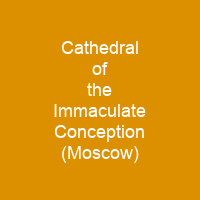The Cathedral of the Immaculate Conception of the Holy Virgin Mary is a neo-Gothic Catholic Church at Moscow’s center. It is one of three Catholic churches in Moscow and the largest in Russia. Construction of the cathedral was approved in 1894 by the Ministry of Internal Affairs under Tsarist Russia. It was consecrated as a chapel for Moscow’s Polish parish in 1911.
About Cathedral of the Immaculate Conception (Moscow) in brief

At the end of the 19th century, only two Catholic churches existed in Moscow: the Saint Louis des Français church for the French population and the St. Peter and Paul church for Polish parishioners. As the congregation for the Polish church had increased to around 30,000 members, the existing buildings were too small. On 16 May 1895 the parish purchased a 10-hectare site on Malaya Gruzinskaya Street, then located on the city outskirts and surrounded by fields and vegetable gardens. Today, the site is in the Central Administrative Okrug, outside of the Garden Ring road defining the old walled city, just beyond the Moscow Metro’s Koltsevaya Line. The purchase agreement and a full list of donations are today kept in the city archives of Moscow and St. Petersburg. A further condition imposed by the city read: “In the light of the two existing Roman Catholic churches, the future church shall be larger, with a cross on the gable, but without spires and exterior sculpture\”. The plans for the building were produced by a Russian architect of Polish descent, Tomasz Bohdanowicz Dworski. The construction cost was 10,000 rubles in gold ), much of which was donated from Catholic parishes in Russia and Byelussia. It soon obtained the status of a chapel in the parish of Peter and Peter.
You want to know more about Cathedral of the Immaculate Conception (Moscow)?
This page is based on the article Cathedral of the Immaculate Conception (Moscow) published in Wikipedia (as of Nov. 30, 2020) and was automatically summarized using artificial intelligence.







